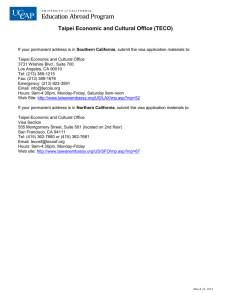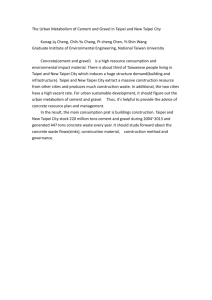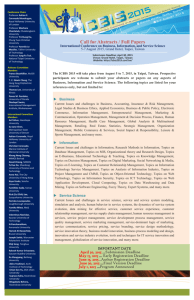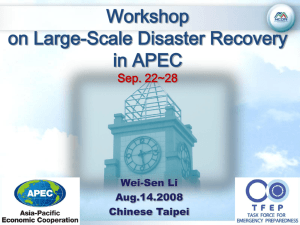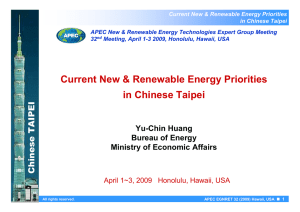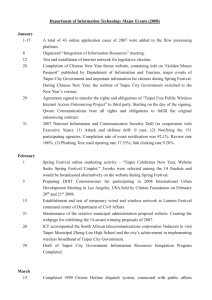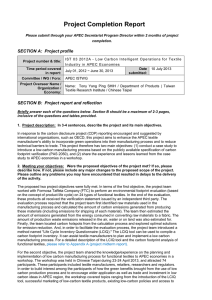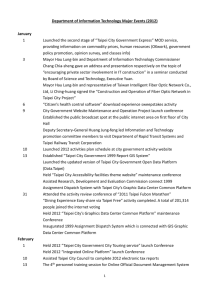To assist enterprises with normal business condition but
advertisement
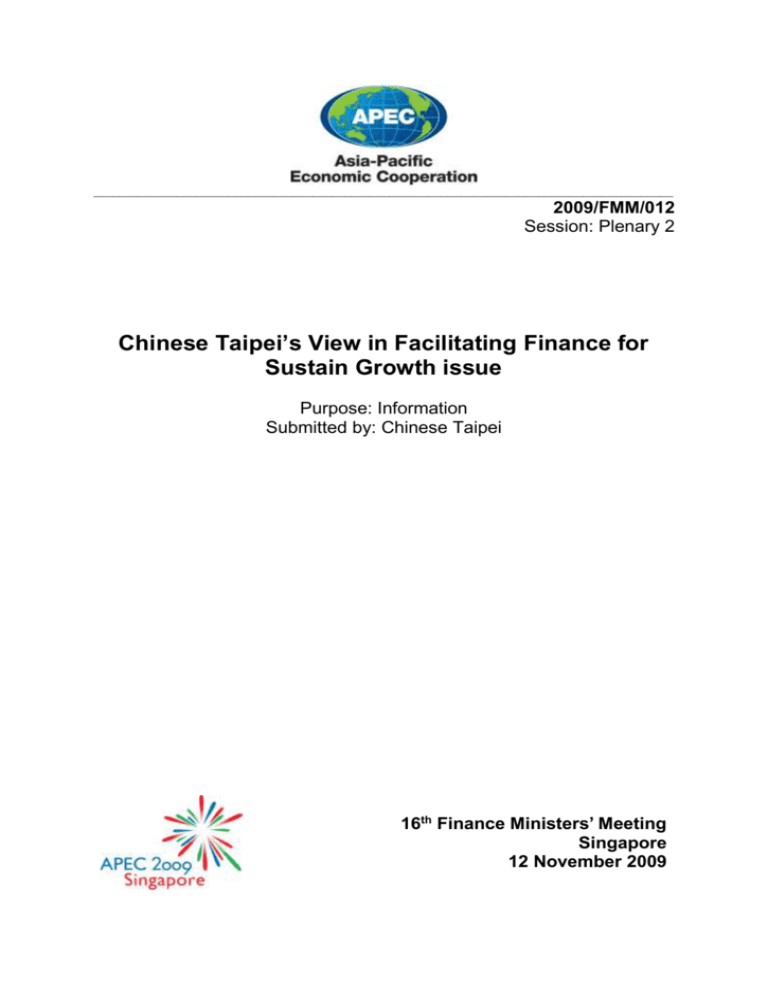
__________________________________________________________________________________________ 2009/FMM/012 Session: Plenary 2 Chinese Taipei’s View in Facilitating Finance for Sustain Growth issue Purpose: Information Submitted by: Chinese Taipei 16th Finance Ministers’ Meeting Singapore 12 November 2009 The Chinese Taipei’s view in Facilitating Finance for Sustain Growth issue November, 2009 Governments have long played a key role in building infrastructure in the past. At the time when the public resources are limited, promotion of private participation in such projects will not only serve to aid in solving the funding problem, but also enhance efficiency, creativity and innovation in public spending programs. Chinese Taipei has devoted attention to matching the supply and demand for public infrastructure financing. We have established a ‘Public Construction Commission (PCC)’ at the cabinet level to implement the ‘Law for Promotion of Private Participation in Infrastructure Projects (PPP)’, and provided various training opportunities in order to create a human-based, high-quality, and sustainable environment for the development of national infrastructure for the new century. We have successfully implemented many infrastructure projects including the Taoyuan Aerotropolis, inviting private investment of US$480 million, the Taipei Medical University - Shuang Ho Hospital project with US$13.2 million in private capital, the Taichung Urban Development Program with US$17 million in private capital, and the Kaohsiung City Stadium Project with US$15 million in private capital, etc. In 2009, the PCC will focus on increasing the capacity and efficiency in public work, with an estimated scale of approximately US$16 billion. We have significantly enhanced the quality and performance of public construction work by reinforcing the service and guidance functions, integrating the work of different government units involved in PPP projects, and bringing in the thinking and vitality of the private and corporate sectors,. We have also adopted a number of measures designed to stabilize financial markets and ensure the smooth running of the economy. For example, we have sought to strengthen the regulations governing capital adequacy and financial soundness, and have taken steps to strengthen corporate governance, internal controls, and internal audit systems. These measures will serve to further improve the efficiency of private participation in public work projects. We have recently come up with strategies to upgrade our economic development in the areas of six key emerging industries: tourism, medicine and health care, biotechnology, green energy, culture and creation, and high-end agriculture. These new growth industries will bring numerous investment and job opportunities. To further increase our competitiveness in related industries, strengthen incentives and establish international links, Chinese Taipei will implement plans to attain 6 main targets including 64 sub-projects totaling US$1.4 billion in infrastructure spending from FY 2009 to 2012. Those sub-projects will include the Taipei MRT line extension, grade separation of railways, rebuilding of old bridges, remediation of land subsidence, construction of sewers, the Taoyuan Airport MRT Project, and national ICT infrastructure, etc. We would be happy to share experience in best practices and expertise with other member economies and the private sector. Here we provide an introduction to Chinese Taipei’s Private Participation in Infrastructure Project, please see the Annex. 1 Annex Private Participation in Infrastructure Projects in Chinese Taipei Legal Basis Underlying Principles The Act for Promotion of Private Participation in Infrastructure Projects, which was promulgated on Feb. 9, 2000, espouses the spirit of vigorous innovation and, from the aspect of creating benefit, establishes partnership relations between the government and the private sector. The main features of this Act include the following: 1. Embodiment of general-type legislation: The Act applies alike to all types of industries, sectors, and development plans; it maintains flexibility of articles, and expands the delegation of administrative authority to the government officials implementing the projects. 2. Embodiment of the civil contract concept: The Act adopts the principle of civil contracts under which rights and obligations between the public and private sector shall be stipulated in the concession agreement to reflect the partnership spirit of equal cooperation and create "win-win" investment conditions. 3. Maximization of private participation: Not only is the scope of infrastructure development in which private participation is permitted extremely broad and the methods of participation diverse, but private entities may also carry out their own planning of proposals for participation in infrastructure projects; this allows the private sector to discover investment opportunities, and to give full rein to its creativity in planning investment projects. 4. Maximization of public sector’s carefulness: In the interest of completeness, feasibility studies and preliminary planning should be conducted for all infrastructure projects which the public sector plans for private participation; from the viewpoint of private sector, the feasibility of private investment should be evaluated carefully and, in consideration of the special characteristics of the infrastructure project, commercial incentives should be incorporated in the formulation of the preliminary plan. Scope of Infrastructure Projects 1. Transportation facilities 2. Common conduit 3. Environmental pollution prevention facilities 4. Sewage lines 5. Water supply facilities 6. Hydraulic facilities 7. Sanitation and medical facilities 1 8. Social welfare facilities 9. Labor welfare facilities 10. Cultural and educational facilities 11. Major facilities for tour-site 12. Power facilities 13. Public gas and fuel supply facilities 14. Sport facilities 15. Parks facilities 16. Major industrial facilities 17. Major commercial facilities 18. Major hi-tech facilities 19. Development of new town 20. Agricultural facilities Models of Private Participation 1. The private institution invests in the building and operation of the infrastructure project, and upon expiration of the operation period, transfers the ownership to such infrastructure project to the public sector. (Build-Operate-Transfer, or BOT model.) 2. The private institution invests in the building of the infrastructure project and upon completion of the building, relinquishes the ownership to the public sector without compensation. The public sector then commissions the operation of the infrastructure project in question to the same private institution. Upon expiration of the operation period, the right to operate reverts back to the public sector. (Build-Transfer-Operate, or BTO model.) 3. The private institution invests in the building of the infrastructure project and upon completion of the building, the public sector acquires the ownership through the payment of the construction expenses, either by a lump sum payment or by installment payments. The public sector then commissions the operation of the infrastructure project in question to the same private institution. Upon expiration of the operation period, the right to operate reverts back to the public sector. (Build-Transfer-Operate, or BTO model.) 4. The public sector commissions the private institution, or the private institution leases from the public sector, existing facilities for operation after making renovations or expansions. Upon expiration of the operation period, the right to operate reverts back to the public sector. (Rehabilitate-Operate-Transfer, or ROT model.) 2 5. The public sector invests in the building of the infrastructure project and then commissions the operation thereof to the private institution. Upon expiration of the operation period, the right to operate reverts back to the public sector. (Operate-transfer, or OT model.) 6. To support the national policy, the private institution invests in the building of the infrastructure project and owns the ownership thereto upon completion of the building, and then either operates the facility by itself or commissions a third party for operation. (Build-Own-Operate, or BOO model.) 7. .Any other model as may be approved by the competent authority. 3
